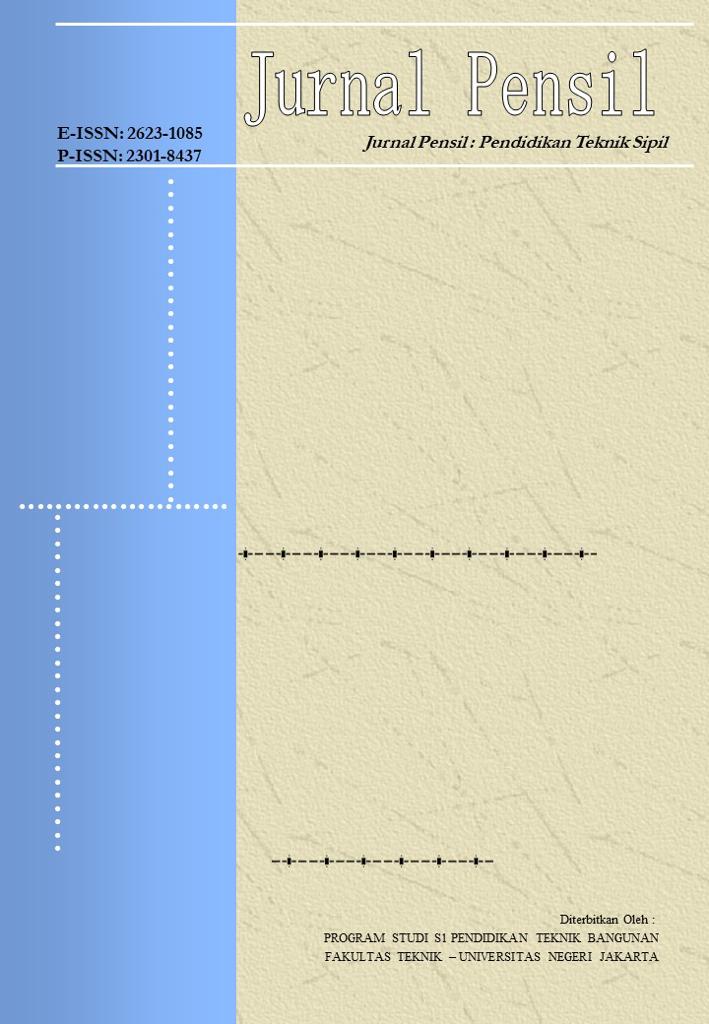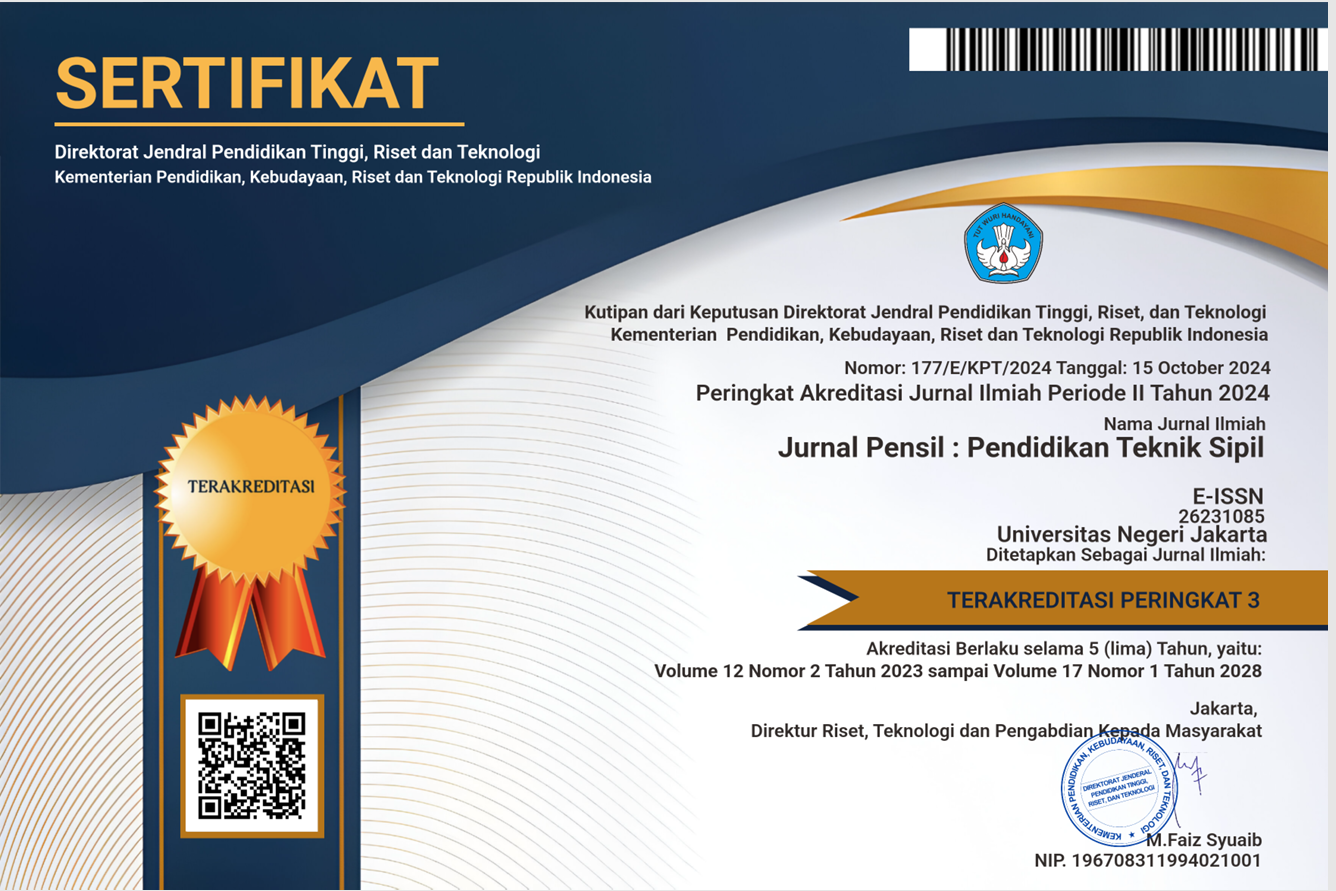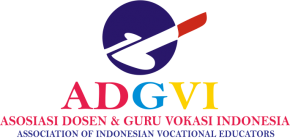RELEVANCE OF BUILDING ENGINEERING EDUCATION CURRICULUM TOWARDS SKKNI BUILDING AND CONSTRUCTION MANAGEMENT COMPETENCIES
DOI:
https://doi.org/10.21009/jpensil.v13i3.48949Keywords:
Relevance, Competencies, Curriculum, Building Engineering EducationAbstract
Indonesia's rapidly growing construction industry is a key economic driver, presenting both challenges and opportunities for graduates of the Building Engineering Education Program. Higher education plays a crucial role in developing competent human resources with the relevant knowledge, skills, and expertise to meet industry needs. This study maps the qualifications of technicians and analysts based on the Indonesian National Work Competency Standards (SKKNI) in the construction sector and analyzes the alignment of competency units with Building Engineering Education State University of Jakarta course outcomes. The analysis of SKKNI data from 2024 found that out of 71 job levels in the building subclassification, 14 are for technicians or analysts at KKNI levels 4 to 6, but only 10 have detailed SKKNI documents. In the construction management classification, there are 39 job levels, with 16 for technicians/analysts, all with detailed SKKNI documents. The analysis indicates that 11 job levels are relevant to Building Engineering Education course outcomes, while two are not. Specifically, several job levels in both subclassifications are rated from Relevant to Very Relevant. To address curriculum gaps, recommendations include strengthening the existing curriculum and adding new courses. This study aims to provide a foundation for curriculum revitalization, ensuring Building Engineering Education graduates are competitive in the labor market and meet the evolving needs of the construction industry.
References
Akyazi, T., Alvarez, I., Alberdi, E., Oyarbide-Zubillaga, A., Goti, A., & Bayon, F. (2020). Skills needs of the civil engineering sector in the european union countries: Current situation and future trends. Applied Sciences (Switzerland), 10(20), 1–24. https://doi.org/10.3390/app10207226
Allais, S. (2011). What is a National Qualifications Framework? Considerations from a Study of National. Journal of Contemporary Educational Studies, 5, 106–124.
Asfiyanur, E. P., Sumardi, K., Hamdani, A., & Abdullah, A. G. (2018). Requirement analysis of work competence of vocational graduates in heavy equipment industry. IOP Conference Series: Materials Science and Engineering, 434(1). https://doi.org/10.1088/1757-899X/434/1/012302
Béduwé, C., & Giret, J. F. (2011). Mismatch of vocational graduates: What penalty on French labour market? Journal of Vocational Behavior, 78(1), 68–79. https://doi.org/10.1016/j.jvb.2010.09.003
Building Engineering Education Study Program. (2024). https://ft.unj.ac.id/program-studi-pendidikan-teknik-bangunan/
Choirunnisa, Ifa; Muladi, Muladi; Devi, M. (2018). Analisis Pengembangan Laboratorium Teknik Instalasi Fiber Optik pada Sekolah Menengah Kejuruan untuk Mencapai Standar Kompetensi sesuai dengan SKKNI dan Kebutuhan DU/DI. Jurnal Pendidikan: Teori, Penelitian, & Pengembangan, 3(1), 62–74. http://dx.doi.org/10.17977/jptpp.v3i1.10374
Disas, E. P. (2018). Link and Match sebagai Kebijakan Pendidikan Kejuruan Link and Match as a Vocational Education Policy. Jurnal Penelitian Pendidikan.
Diwangkoro, E., & Soenarto, S. (2020). Development of teaching factory learning models in vocational schools. Journal of Physics: Conference Series, 1456(1). https://doi.org/10.1088/1742-6596/1456/1/012046
Falakh, F. (2022). Identifikasi Standar Kompetensi Kerja Nasional Indonesia (SKKNI) pada Pengembangan Kurikulum Program Studi Teknik Lingkungan. Journal on Education, 04(04), 1796–1802. http://jonedu.org/index.php/joe
Kementerian PUPR. (2022, January 19). 2023, Sektor Konstruksi Serap 8.769.798 Tenaga Kerja. Https://Bpiw.Pu.Go.Id/.
Khurniawan, A. W. (2019). Turbulensi Dalam Revitalisasi SMK (Pertama). UNY Press.
Langie, G., & Craps, S. (2020). Professional competencies in engineering education: The PREFERed-way. Informacios Tarsadalom, 20(2), 142–153. https://doi.org/10.22503/INFTARS.XX.2020.2.10
Leifler, O., & Dahlin, J. E. (2020). Curriculum integration of sustainability in engineering education – a national study of programme director perspectives. International Journal of Sustainability in Higher Education, 21(5), 877–894. https://doi.org/10.1108/IJSHE-09-2019-0286
Mancotywa, Y. L. (2023). Repurposing Rural Technical Vocational Education and Training in South Africa.
Menteri Ketenagakerjaan Republik Indonesia. (2020). Keputusan Menteri Ketenagakerjaan Republik indonesia No. 333 Tahun 2020.
Muhammad, I., & Ariani, S. (2020a). The Development of KKNI-Based Curriculum at the Arabic Language Education Programs in Indonesian Higher Education. Jurnal Ilmiah Peuradeun, 8(3), 451–474. https://doi.org/10.26811/peuradeun.v8i3.543
Muhammad, I., & Ariani, S. (2020b). The Development of KKNI-Based Curriculum at the Arabic Language Education Programs in Indonesian Higher Education. Jurnal Ilmiah Peuradeun, 8(3), 451–474. https://doi.org/10.26811/peuradeun.v8i3.543
Muja, A., Blommaert, L., Gesthuizen, M., & Wolbers, M. H. J. (2019). The vocational impact of educational programs on youth labor market integration. Research in Social Stratification and Mobility, 64. https://doi.org/10.1016/j.rssm.2019.100437
Nkwanyane, T. P. (2023). Understanding the Demand for Industrial skills through the National Certificate (Vocational) Building and Civil Engineering Programme. International Journal of Learning, Teaching and Educational Research, 22(5), 674–687. https://doi.org/10.26803/ijlter.22.5.35
Oroh, R. R. (2023). Analysis of the Need for Construction Services towards the Minimum Competency Standards for Vocational Student Work Attitudes. In IJEVSS (Vol. 02).
Pratidina Tenda, M., Syamsul Bahri, E., & Lumataw, J. A. (2024). Indonesian National Job Qualifications: Literature Review. JOURNAL OF PSYCHOLOGY AND SUSTAINABLE EDUCATION (JPSE), 1(2). https://journal.p2ti.com/index.php/jpse/index
Program Studi S1 Pendidikan Teknik Bangunan. (2024). https://ft.unj.ac.id/program-studi-pendidikan-teknik-bangunan/
Ramadhan, M. A., Iriani, T., & Handoyo, S. S. (2013). Relevansi Kompetensi Lulusan SMK Khususnya Kompetensi Keahlian Teknik Gambar Bangunan dengan Kompetensi yang Dibutuhkan di Dunia Kerja. Jurnal PenSil, 2(1), 1–10. https://doi.org/10.21009/jpensil.v2i1.7282
Reducing red tape essential for economic growth. (2012, April 30). Https://Www.Ceda.Com.Au/Newsandresources/News/Government-Regulation/Reducing-Red-Tape-Essential-for-Economic-Growth. https://www.ceda.com.au/newsandresources/news/government-regulation/reducing-red-tape-essential-for-economic-growth
Rezqiana, A., Eka Murtinugraha, R., & Widiasanti, I. (2023). Identifikasi Kompetensi yang dibutuhkan Tenaga Ahli Teknik Bangunan Gedung pada Industri Konstruksi. https://doi.org/10.36312/jcm.v3i1.1916
Samsul, E., Muchtar, H., & Mahbubul, W. (2023). Pelatihan Unit Kompetensi Mengoperasikan PLC SKKNI 631 Tahun 2016 untuk Guru Mekatronika SMK Negeri 10 Bekasi. BERNAS: Jurnal Pengabdian Kepada Masyarakat, 4(1), 219–228. https://doi.org/https://doi.org/10.31949/jb.v4i1.3997
Santoso, M., Firdaus, A. R., Djajanto, L., & Prayogo, R. D. R. B. P. (2022). Panduan Penyusunan Kurikulum Pendidikan Tinggi Vokasi.
Setiyawami, Sugiyo, Sugiyono, & Rahardjo, T. J. (2019). The Industrial Revolution 4.0 Impact on Vocational Education in Indonesia. ICONECT, 3–7. https://doi.org/10.4108/eai.20-8-2019.2288089
Solikhah, I. (2015). KKNI dalam Kurikulum Berbasis Learning Outcomes. LINGUA: Journal of Language, Literature and Teaching, 12(1), 1–22.
Stanway, J. , B. A. , R. M. , S. T. , B. A. , C. D. , H. S. , P. G. , E. S. , E. D. , & C. S. (2023). National Seismic Qualification Framework for Non-Structural Elements. CONFER.NZ/SESOC2023.
Sudira, P. (2019). The Role of Vocational Education in the Era of Industrial Automation. Journal of Physics: Conference Series, 1273(1). https://doi.org/10.1088/1742-6596/1273/1/012058
Sulistianingrum, M., Murtinugraha, E., & Daryati. (2023). 35970-Article Text-106668-1-10-20230904. Prosiding Seminar Pendidikan Kejuruan Dan Teknik Sipil, 1, 56–63.
Suyanto, W., & Sofyan, H. (2017). Vocational Education Development Framework in 21 st Century. Advances in Social Science, Education and Humanities Research, 102, 395–398.
Suyono, Basori, I., Syamsuir, & Syaefudin, E. A. (2023). Pedoman Akademik 2023/2024 FT Fakultas Teknik Universitas Negeri Jakarta. In PEDOMAN AKADEMIK 2023/2024 FT Fakultas Teknik Universitas Negeri Jakarta.
Utami, S., Widarto, W., & Arifah, S. (2022). Relevance Employability Skills of Vocational High School Students’ Department of Sanitation Building Construction and Maintenance in Diy To the Construction Service Industry. Jurnal PenSil, 11(3), 186–196. https://doi.org/10.21009/jpensil.v11i3.27157
Utomo, W. (2021). Paradigma Pendidikan Vokasi : Tantangan, Harapan Dan Kenyataan. Assessment, and Evaluation Education, 1(2), 65–72. http://almufi.com/index.php/AJMAEEhttp://almufi.com/index.php/AJMAEE
van der Molen, H. F., Basnet, P., Hoonakker, P. L. T., Lehtola, M. M., Lappalainen, J., Frings-Dresen, M. H. W., Haslam, R., & Verbeek, J. H. (2018). Interventions to prevent injuries in construction workers. Cochrane Database of Systematic Reviews, 2018(2). https://doi.org/10.1002/14651858.CD006251.pub4
Wibowo, S., Darnita, Y. D. Y., & Muntahanah, M. (2022). Workshop Network Administrator Muda Dalam Kompetensi Kerja di Era Industri 4. 0. Abdi Reksa, 3(1), 16–22. https://ejournal.unib.ac.id/index.php/abdireksa/article/view/17860
Wijayanti, M., & Jaedun, A. (2019). Relevansi Kompetensi Lulusan Kejuruan Teknik Bangunan untuk Bekerja Di Industri Konstruksi. Jurnal Kependidikan, 3(1), 81–94.Wirda, M. A., & Rahmad, R. (2019). Developing of The Demography Teaching Book Based on KKNI-Curriculum and High Order Thinking Skills.
Yuwono, U. (2019). Ideologies underpinning the Indonesian National Qualification Framework (IQF) for higher education website text. Indonesian Journal of Applied Linguistics, 8(3), 668–677.
Additional Files
Published
How to Cite
Issue
Section
License
Copyright (c) 2024 Ansheila Rusyda Subiyantari, Abdhy Gazali, Santoso Sri Handoyo, Shilmi Arifah

This work is licensed under a Creative Commons Attribution-ShareAlike 4.0 International License.











.png)
.png)
1.png)

